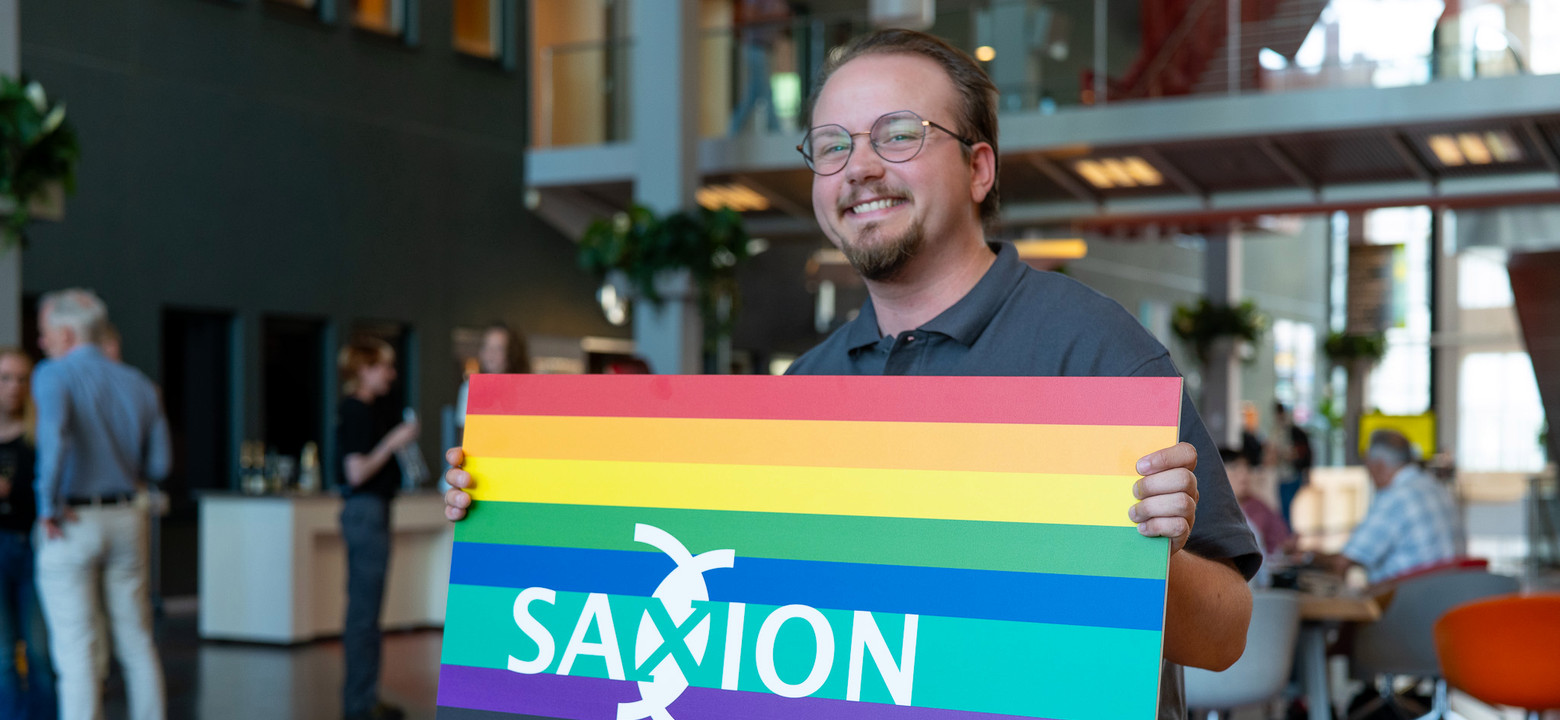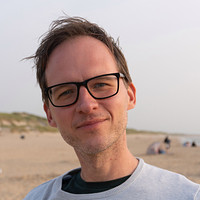Saxion Pride emblem: ‘normalisation, that’s where we need to be heading’
As of now, Saxion has an official Pride emblem: a variant of the organisation logo that can be used to convey support for the LGBTIQ+ community to the outside world. We talk to Stahn Moes, chair of the Queer student association, about the creation and meaning of the emblem: “What I hear around me is that people really appreciate this extra support. It increases the feeling of being welcome.”
Stahn Moes is calling from a student house in Zutphen, within ‘train distance’ of Saxion Deventer, home base of student association Queer (SV Queer). Our topic for discussion today: the brand new Saxion Pride emblem. First of all: what exactly should such an emblem make us think about? “It is a variant of the Saxion logo,” says Stahn, “which can be used during LGBTIQ+ related events. For example, we, as study association Queer, sometimes provide an educational seminar, or are present at the Deventer Pride. These are things that Saxion takes part in. Having an emblem is a good way of showing that you are proud of your contribution. From the idea that we not only take part, but it is also what we stand for. It shows that extra step of support.”
The need for an official Pride emblem had already been evident for some time to the Saxion Diversity Office, that also played a key role in the design process along with SV Queer. Or rather, it is mainly about an underlying need: showing commitment during LGBTIQ+ related events and happenings. When asked whether the expression of that extra commitment is really so necessary, Stahn responds: “Nowadays, I think that it is pretty much needed. Our members notice that too... Sometimes there are other students who think it's normal to harass us. This has intensified more recently.”

Stahn with the new Saxion Pride emblem.
Acceptance
Stahn hastens to say that this harassment is often a case of ‘bad-boy behaviour’. All the same, it is primarily about behaviour that can make people feel unaccepted. And let that be one of the most important goals of the Pride emblem: to contribute to a sense of acceptance among all Saxion students. “Fortunately, Saxion and the school where we as SV Queer, are located, clearly reject negative behaviour directed at us,” says Stahn. “They really support us. However, that does not alter the fact that this can lead to a certain feeling of being unsafe. The feeling that you don’t belong. Things like the Pride emblem, no matter how small it may seem, prove the opposite is true.”
The design phase of the Pride emblem was all about close cooperation “Our entire board was involved,” tells Stahn. “We were not only allowed to watch but also help decide. During meetings we were able to clearly give our opinion. During the emblem’s creation process we felt like true contributors. At a later stage, a choice had to be made between three possible versions of the Pride emblem. How did one of those versions eventually emerge as the winner? Stahn: “It is a quite straightforward logo. Simple but clear. If you make it more complicated, it would only become less recognisable. The emblem needs to be ‘recognisable as Saxion’; it is Saxion that is making a statement. Furthermore, this emblem has simply got the right vibe.”
We have to continue with this energy. The initiatives are already there, as are the people who are happy to contribute too. Ride the wave.
International
Although the Pride emblem is still new, there are already some initial reactions within Saxion. “I’ve also seen the other members,” says Stahn, “to ask what the emblem means to them. What I hear around me is that people really appreciate this extra support. It increases the feeling of being welcome. What I particularly value – looking from a director’s perspective – is that we have been asked for our opinion. That we’ve been included in the process confirms how I see Saxion: as supportive and willing. The very fact that I can say this is already valuable to me. It shows what Saxion as organisation, stands for. What we stand for together. The emblem makes this visible in a broader sense than just an email signature. This helps us communicate not as two separate groups, but as one.”
What does the Pride emblem mean specifically for the international members of SV Queer? “We certainly have quite a few international members,” says Stahn, “also from countries where being queer is absolutely ‘not done’. Those members have made a conscious decision to come to the Netherlands to study. Among other things, for the freedom and individuality that our country is renowned for. These are things that some international members crave.”
Down to earth
Stahn incidentally mentions the example of an association member who will probably never be able to return to their country of origin, purely because of the hostility that prevails there towards the queer community. Stahn continues: “The idea that you can genuinely be yourself here – not only in a social circle but also on an organisational level – creates a sense of security and pride. Here you are allowed to be who you are. I think it would be a great pity if we in the Netherlands were to hide our own values because of other people’s opinions or culture. I know that’s a kind of prevailing energy at the moment, but that’s not how the majority of Dutch people view their own culture. We are tolerant, and that’s the way we like to see ourselves. I think that makes the emblem a strong image.”
Stahn expects that the Pride emblem will help generate more support in the region. For example, from the municipality of Deventer that already cooperates a lot with Saxion and SV Queer. At the same time more than just an emblem is needed. Stahn: “There is a lot happening behind the scenes. We are consulting with schools over all manner of plans and ideas. I do think that more could be implemented though. Where we don’t just dream about what would be good or useful, but that we also actually implement initiatives. I hope that the emblem can be the first step in doing this. We have to continue with this energy. The initiatives are already there, as are the people who are happy to contribute too. Ride the wave. Even if it is sometimes three steps forward and two steps back, we still roll forwards albeit slowly.”
Ride the wave. It is a message full of hope. “After I started being honest about who I am,” Stahn remembers in conclusion, “then people said: your grandpa and grandma won’t understand it, they are from another era. However, my grandpa and grandma, born and bred ‘Tukkers’ [from the Twente region], said: it could have happened to me too, as long as you are happy. This normalisation, that’s where we need to be heading."
Photography: Thomas Busschers
